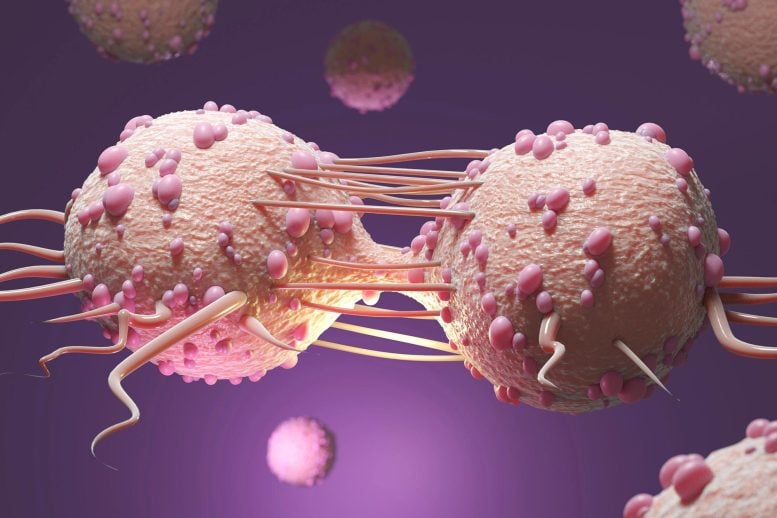
A study reveals DNA and RNA epigenetics work together as a complementary system for precise gene regulation, crucial for cell function and development, with implications for advanced cancer therapies.
Our genes carry the complete set of instructions necessary for our body to function, but their expression must be carefully regulated to ensure that each cell fulfills its specific role efficiently. This is where DNA and RNA epigenetics come into play: a collection of mechanisms that act like “markers” on genes, controlling their activity without altering the underlying DNA or RNA sequences.
Traditionally, DNA and RNA epigenetics have been studied as separate systems. These two mechanisms were thought to operate independently, each contributing to different stages of the gene regulation process.
Perhaps that was a mistake.
In a publication in the journal Cell, researchers led by François Fuks, the Laboratory of Cancer Epigenetics, ULB Faculty of Medicine, ULB-Cancer Research Center, and Jules Bordet Institute, H.U.B. reveal that in fact, DNA and RNA epigenetics could be more interconnected than previously thought. The researchers have discovered that they form a complementary regulation system, in which DNA epigenetics organizes the available genes and RNA epigenetics dynamically adjusts their use.
How Dual Epigenetic Markers Work
In concrete terms, the study demonstrates that when these two markers are added jointly to a gene, they enable a more effective activation of that gene. On the other hand, if one of these processes is not working correctly, the gene’s activity diminishes. François Fuks and his colleagues have shown that this mechanism is particularly important in key stages like cells’ development or their specialization into different types, for example in embryonic stem cells.
This combination offers incredibly precise regulation of gene activity, essential to the development of organisms and the harmonious functioning of cells.
Implications for Biology and Medicine
Published on January 17 in the journal Cell, this fundamental breakthrough sheds light on a completely new mode of gene control, opening up unprecedented perspectives in biology. It helps us to gain a better understanding of how our cells work and how disruptions to these mechanisms can cause diseases like cancer.
This discovery could also lead to advances in cancer treatments. Making use of this complementary regulation system raises the prospect of developing therapies based on “epigenetic drugs” that target DNA and RNA at the same time. The scientists hope to be able to develop more precise and personalized treatments, capable of targeting these regulation mechanisms to restore balance to diseased cells in cancer patients.
Prof. Fuks’ team is already carrying out research connected directly to the work published in Cell. These ongoing studies aim to demonstrate the clinical usefulness of their discovery, by exploring the potential of epigenetic therapies acting on DNA and RNA.
Reference: “Fine-tuning of gene expression through the Mettl3-Mettl14-Dnmt1 axis controls ESC differentiation” by Giuseppe Quarto, Andrea Li Greci, Martin Bizet, Audrey Penning, Irina Primac, Frédéric Murisier, Liliana Garcia-Martinez, Rodrigo L. Borges, Qingzeng Gao, Pradeep K.R. Cingaram, Emilie Calonne, Bouchra Hassabi, Céline Hubert, Adèle Herpoel, Pascale Putmans, Frédérique Mies, Jérôme Martin, Louis Van der Linden, Gaurav Dube, Pankaj Kumar, Romuald Soin, Abhay Kumar, Anurag Misra, Jie Lan, Morgane Paque, Yogesh K. Gupta, Arnaud Blomme, Pierre Close, Pierre-Olivier Estève, Elizabeth A. Caine, Kristin M. Riching, Cyril Gueydan, Danette L. Daniels, Sriharsa Pradhan, Ramin Shiekhattar, Yael David, Lluis Morey, Jana Jeschke, Rachel Deplus, Evelyne Collignon and François Fuks, 17 January 2025, Cell.
DOI: 10.1016/j.cell.2024.12.009
The work is supported by the F.N.R.S, Télévie, Welbio, the Belgian Foundation Against Cancer, an ARC (Action de Recherche Concertée – Collective Research Initiative), the ULB Foundation and Wallonia.
Never miss a breakthrough: Join the SciTechDaily newsletter.
10 Comments
Biology
This sounds like a huge leap forward for medicine.
Would this same combo approach to dna RNA work for autoimmune diseases like ulcerative colitis, lupus, Crohn’s disease, rheumatoid arthritis, etc.?
This is a HUGE step forward for science
Nice
I have behcets disease and autoimmune disease were my immune system attacks it’s self it lays dormit but when it’s active I get open lessions all over my body genetals and in the mouth feels like sigar burns I also have rumitoid arthritis,fibermialga and my bones break easily because I was on Prednisone for so long and get blood clots palmanery embolism. I got this disease when I was 19 and I’m 47 now it would be nice to have a cure for it or something
Fuk that, sounds like more mRNA jabs to me. I thought they already realised that when used for trying to cure cancer, more than one mrna jab caused more cancer?
Sounds about right..
Biology
That’s awesome achievement of research.my gut says finally can I cure cancer that’s a unbelievable
THANK YOU
All newly born infants should have manitory DNA, RNA testing, and it should affordable to all